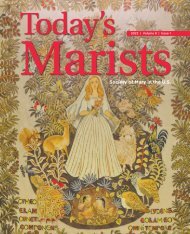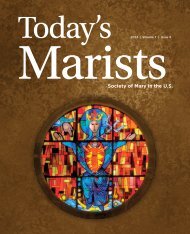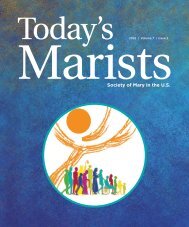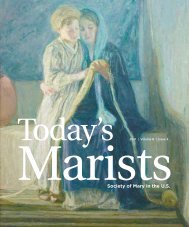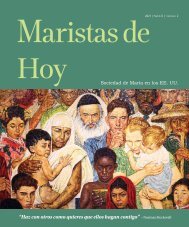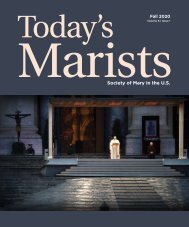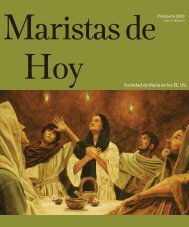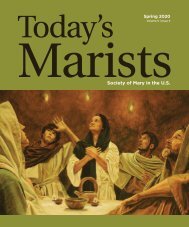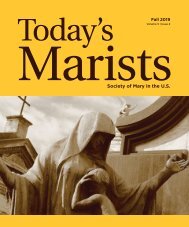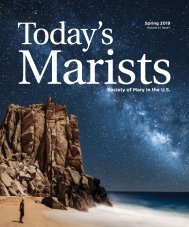Today's Marists 2024 Volume 8, Issue 2
You also want an ePaper? Increase the reach of your titles
YUMPU automatically turns print PDFs into web optimized ePapers that Google loves.
Killers of the Flower Moon:<br />
An Invitation to Solidarity?<br />
by Nik Rodewald, Theology Teacher and Campus Minister, Marist School, Atlanta, Georgia<br />
On January 7, <strong>2024</strong>, Lily Gladstone became the first Native<br />
American to win the Golden Globe Award for Best Actress (Drama).<br />
On screen, Gladstone portrays Mollie Burkhart in Martin Scorsese’s<br />
film, Killers of the Flower Moon, a drama based on the true story<br />
of a series of murders of members of the Osage nation. The film,<br />
boasting an all-star cast including Leonardo DiCaprio (Ernest<br />
Burkhart) and Robert Di Niro (William King Hale), was nominated<br />
for ten Academy Awards.<br />
Gladstone, who is of mixed Piegan Blackfeet, Nez Perce and<br />
European heritage, began her Golden Globe acceptance speech<br />
with an introduction in Blackfeet language. Gladstone then<br />
thanked her mother, saying “I’m here with my mom, who, even<br />
though she’s not Blackfeet, worked tirelessly to get our language<br />
into our classrooms so I had a Blackfeet language teacher growing<br />
up.” I believe that both Gladstone’s on-screen performance and<br />
her off-screen family story suggest a path towards solidarity with<br />
Indigenous communities for white, American Catholics.<br />
Killers of the Flower Moon and the Flame<br />
of Collective Conscience<br />
Racism, dehumanization and greed mark the plot of Killers of the<br />
Flower Moon. After discovering oil on their Oklahoma reservation,<br />
the Osage tribe formed the Osage Mineral Estate, which managed<br />
the oil leases for their tribal lands. Because there were 2,229<br />
members of Osage nation when the trust was created in 1906, 2,229<br />
headrights were created, entitling the holder of each headright to<br />
a quarterly share of revenues. The tribe thus became remarkably<br />
wealthy, but with a catch. The 1906 Burke Act required white<br />
legal guardians to manage the financial affairs of those Native<br />
Americans determined to be “incompetent.” Because competency<br />
was determined by blood quantum, all full and half-blood Osage<br />
members were considered “incompetent” and were required<br />
by law to have a white guardian. This practice allowed for the<br />
widespread exploitation of Osage by white people.<br />
Within this political context, the film relays a sinister story. Ernest<br />
Burkhart (Leonardo DiCaprio) moves to Oklahoma to work for<br />
his uncle, William King Hale (Robert Di Niro), a cattle rancher<br />
who has earned the trust of the Osage. After Ernest marries Mollie<br />
(Lily Gladstone), Hale orders the killings of many Osage, including<br />
Mollie’s family, to increase the headrights that Ernest, Mollie’s<br />
white, competent spouse, will control. The film’s drama pits Hale’s<br />
macabre scheme against Mollie’s persistent yet subdued efforts at<br />
uncovering truth and demanding accountability.<br />
While the film has received critical acclaim, some Indigenous<br />
voices have criticized the film. Mohawk actress Devery Jacobs<br />
emphasizes that “each of the Osage characters felt painfully<br />
underwritten, while the white men were given way more courtesy<br />
and depth.” Moreover, Jacobs takes issue with the portrayal of<br />
violence in the film: “I believe that by showing more murdered<br />
Native women on screen, it normalizes the violence committed<br />
against us and further dehumanizes our people … our pride for<br />
being Native, our languages, cultures, joys and love are way more<br />
interesting and humanizing than showing the horrors white men<br />
inflicted upon us.”<br />
Indigenous commentator Kate Nelson agrees that the film’s<br />
emphasis on Hale’s corruption positions “the white perpetrators<br />
as the protagonists of the plotline while pushing the Osage people<br />
12 Today’s <strong>Marists</strong> Magazine



